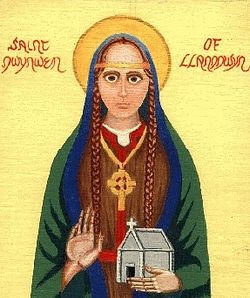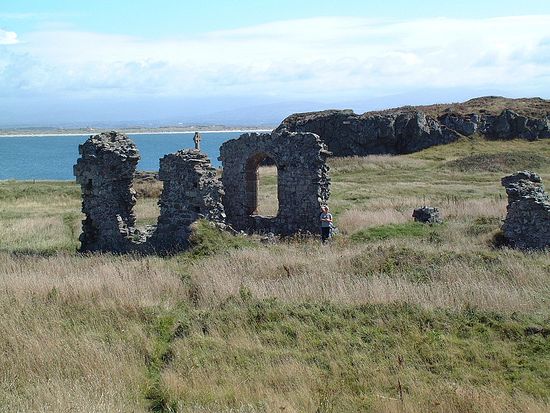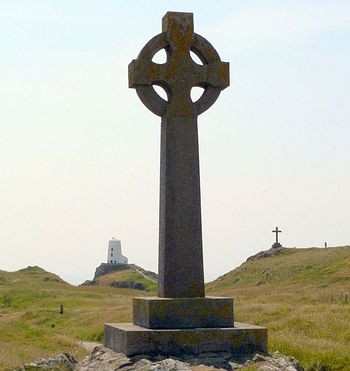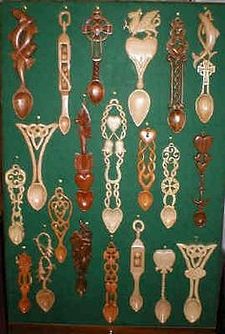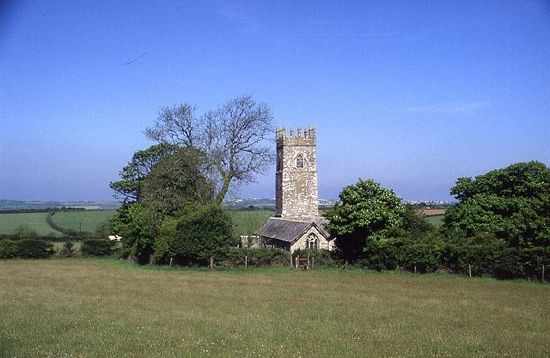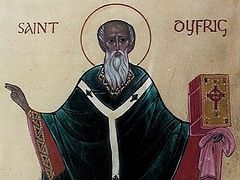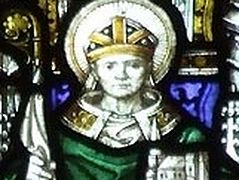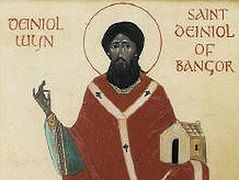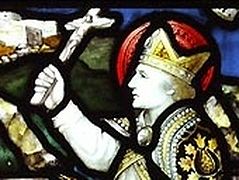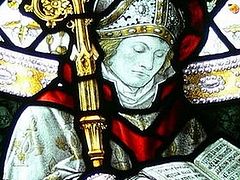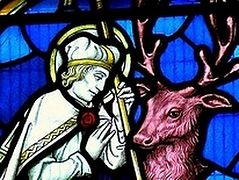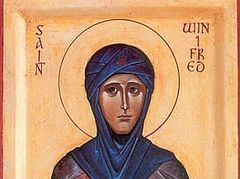One of the most celebrated female saints of Wales is Venerable Dwynwen (also Donwenna: + c. 460; according to another version: fifth-sixth centuries). The name “Dwynwen” means “she who leads a blessed life”. She hailed from Wales and was famous for her ascetic life. Little genuine information on this early Welsh saint is known, however, pious people in Wales and Cornwall greatly venerated and loved this saint throughout the centuries.
According to later legends, Dwynwen was one of the numerous children of the Holy Right-Believing King Brychan of Brecknock in South Wales. A young man named Maelon, amazed by the beauty and devout Christian life of Dwynwen, wished to marry her. But the holy maiden, who longed for ascetic life in seclusion and virginity, refused to marry him and began to pray hard so that God did not allow this marriage. (According to other versions, young Dwynwen herself fell in love with this man but her ardent desire to become an anchoress overcame her; or, for some reason, she could not marry him – probably because of her father’s opposition). Then Maelon decided to take the maiden by force. But, before he could carry out his wicked plot, an angel appeared to Dwynwen in a dream and gave her a potion to drink. At the same moment Dwynwen felt as if she was cured from some disease, but also in the same instant Maelon was turned to ice.
Having learned about the misfortune that befell the man, Dwynwen pleaded to God that Maelon be returned to life immediately and that all sincere and wholehearted prayers of the faithful for a firm Christian marriage be always fulfilled through her intercessions (or, if it was against the will of God, that they be freed from their desires to marry). The Lord heard her prayer: Maelon was “thawed” at once, and the saint of God became the heavenly protectress of those in love and those seeking a husband or a wife.
Whatever the exact truth of all this, as her thanksgiving to God for help Dwynwen chose to live as an anchoress in full seclusion till the end of her life. So she retired to a remote and tiny islet just to the west of the larger isle of Anglesey off the northwestern Welsh coast and lived there for some sixty years in holiness, unceasing prayer and communion with God. By the end of her life the holy virgin may have founded a small monastic community on her isle, but there is not sufficient evidence to prove the existence of a convent there. Also, according to some traditions, the saint built a chapel or a church on her isle, for which she carried heavy stones alone from the coast, and also studied the healing qualities of local herbs and thus cured from many diseases people who came to her from all corners of Wales. The saint reposed and was buried on the same isle that has been known as Ynys Llanddwyn (“Island of the Church of Dwynwen”) since then in her honor.
Whether the account of Maelon and Dwynwen’s failed marriage is a true story or just a later romantic legend, it is certain that this saint led an ascetic life in Llanddwyn for many years and became the patron of love and marriage afterwards for very many centuries. Thousands of pilgrims from Wales and even beyond flocked to her chapel, the shrine with her relics and the holy wells associated with her at Llanddwyn every year, in spite of the extreme remoteness of that site, and asked for her protection – and numerous miracles were recorded. The shrine of St. Dwynwen was so famous that it rivalled St. David’s Cathedral with the shrine of St. David and the holy well of St. Winifred at Holywell in popularity in Wales.
Especially young men and girls from Wales and other parts of Britain used to come to St. Dwynwen at Llanddwyn, fervently pray, asking for her protection and granting a blessed and successful marriage through her intercessions – and many received that what they asked for. In the Middle Ages the chapel (and later church) in Llanddwyn was enlarged and many times received generous donations as an expression of believers’ gratitude for its patron-saint’s prayers. The medieval church must have been very splendid, and it certainly had a golden statue of its patroness. Wax candles were permanently lit around the saint’s shrine and the local parish gradually became one of the richest ones in North Wales. The prominent Welsh poets Dafydd ap Gwilym (mid-fourteenth century) and Dafydd Trefor (in c. 1500) both visited Llanddwyn and praised its beauty and spirituality, along with the virtues of St. Dwynwen, in verses of their poems. A number of very touching songs were dedicated to the saint over the centuries.
The petitions of many pilgrims who were in love or asked for a lifelong husband or a wife were fulfilled after their prayers near St. Dwynwen’s relics as well as by her holy well. In the Middle Ages there appeared many superstitions about her holy well in particular. Many believed that the saint revealed to them the will of God right beside the well, and the answer could supposedly be seen from movement of the fish (especially the “sacred eels” of Dwynwen) which lived in the spring. For example, if a girl threw her handkerchief on the surface of St. Dwynwen well and it disturbed the eel that lived there, this meant that the faithfulness of her future partner was guaranteed. If the water of the neighboring “wishing well” began to “boil” when a pilgrim was coming up, it meant a successful marriage in the near future. Despite the great distance, proximity to the forest and prohibition of the veneration of saints after the Reformation, the influx of pilgrims continued even for some time after Henry VIII.
St. Dwynwen, however, helped not only lovers, but also the sick and even animals. Many farmers of Wales considered her their and their animals’ heavenly patron. Countless cases of healing from various ailments near her relics and holy wells were recorded (cures from different aches, pleurisy, warts); miracles continue to occur even nowadays. Today only stone ruins remain of the once large church of St. Dwynwen in Llanddwyn. Llanddwyn Island (“Ynys Llanddwyn” in Welsh) is attached to Anglesey, but becomes a separate isle at high tide. It is situated in the Irish Sea and separated from mainland Wales by the Menai Strait. On a clear day Snowdon – the highest mountain in Wales – along with the Wicklow Mountains in eastern Ireland can be seen from here at the same time. Llanddwyn is currently uninhabited.
The church ruins and other memorial objects of the islet are located on the territory of a nature reserve. It is said that Dwynwen’s holy well has partly survived and it is now a small trickle of water running down from a rocky cliff. It is situated some thirty steps north of the church ruins. There are also several “candidates” as holy wells associated with our saint from among numerous springs that can be found on the isle and even one on mainland Anglesey. Though it is difficult to identify the exact location of the true holy well, miracles still abound on account of the faith of pilgrims.
Llandwyn Island also has a small museum dedicated to the memory of St. Dwynwen – it is located in the formerly abandoned Pilot’s Cottages. Some historians believe that St. Dwynwen’s holy relics may lie buried somewhere close to her original church. Archeological excavations began on this site several years ago and plans to partly restore the site were announced. Llanddwyn Island is noted for its beautiful nature, coastal dunes, colored flowers, and varied wildlife, with even some rare species of plants and birds. The nearest village to Llanddwyn is Newborough on Anglesey.
The revival of the veneration of St. Dwynwen began in the nineteenth century, when a fourteen-foot-tall cross was erected in her memory close to the church’s ruins (the supposed site of her hermitage), and in 1903 a Celtic-style St. Dwynwen’s cross was installed nearby. From the 1960s on the veneration of Dwynwen as the patroness of lovers developed a very secular nature, becoming analagous to “St. Valentine’s Day”. In recent times, the council of the Welsh county of Gwynedd in north-western Wales has been promoting the day (feast) of St. Dwynwen – Dydd Santes Dwynwen—as the official day of lovers.
Today on the feast-day of St. Dwynwen according to the old calendar (January 25) some Welsh people give those of the opposite sex cards the words “Dwi'n dy garu di!” (that is, “I love you!”) and flowers. The most skilled men used to carve special wooden “love spoons” as gifts for their loved ones for this day (this custom began as early as the seventeenth century, and originally love spoons were very ornate with numerous signs symbolizing love, faithfulness, care, tenderness, and eternity on them). Some Welshmen prefer to propose to their sweethearts precisely on January 25. There is also a revival of Dwynwen’s veneration as a protectress of farm animals.
Apart from Llanddwyn, several other Welsh place-names bear the name of this saint, for example, Porthddwyn. Besides, in the north of the county of Cornwall (England), near the River Camel, there is the little village of Advent, whose Cornish name is “Sen Adhwynn” and Welsh name, “Santes Dwynwen”. The local parish church, the earliest parts of which are from the fifteenth century, is dedicated to “Saint Adwen”, or “Saint Adwenna”, who is described as a daughter of King Brychan of Brecknock and patroness of sweethearts in Cornwall – she is identified by many researchers with our St. Dwynwen.
We hope and pray that the veneration of this ancient Orthodox saint, patroness of love and marriage, will increase among Orthodox Christians as well.
Holy Mother Dwynwen of Llandwyn Island, pray to God for us!

